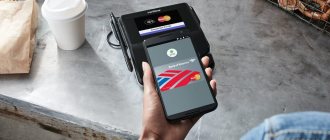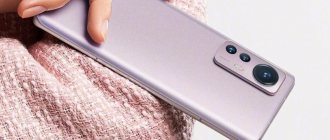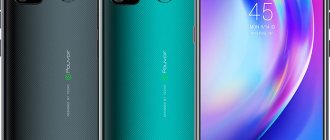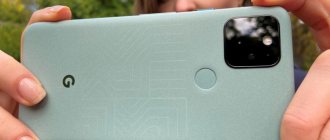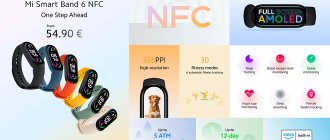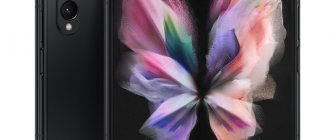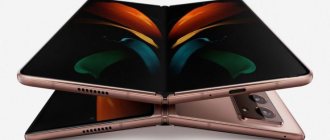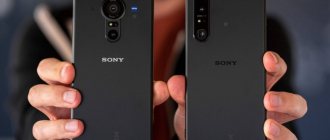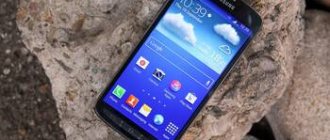Nowadays you won’t surprise anyone with a mobile phone with 2 SIM cards. And such devices are really convenient to use, especially for those who travel frequently or who use regional tariff plans but often travel outside their home region.
But few people know that there are also three-SIM phones. And they are quite in demand, especially in the corporate sector. But which phone with 3 SIM cards is recommended to buy? Which of them do users themselves consider the best?
MAXVI M5
Phone with three SIM cards MAXVI M5
Inexpensive, push-button, in a classic case. This phone for 3 SIM cards is partially made of metal, including internal reinforcing ribs (prevent deformation when dropped).
Although the manufacturer does not claim shock protection, it is still present.
Characteristics:
- screen - 2.4 inches with a resolution of 320 by 240 pixels (65 thousand colors);
- battery - 1000 mAh (removable);
- communication - GSM only;
- there is an input for a memory card (only up to 16 gigabytes);
- 1.3 megapixel camera;
- FM radio support (no need to use headphones).
The OS is proprietary, but there is support for Java, so even Opera Mini can be installed. For basic needs this is enough.
Otherwise, this phone with 3 SIM cards is designed only for calls, sending and receiving SMS messages. Support for MP3 and video playback is present, but there are no additional settings for the same equalizer.
There is only one drawback - the lack of a flash for the camera, which could be used as a flashlight.
BQ BQM-2601 Las Vegas
Another model from BQ, only this time with a much larger screen. Another feature is that the phone is offered in various color shades, including even red or blue.
- Screen diagonal: 2.6 inches
- Resolution: 320×240
- Type of ringtones: polyphonic, MP3 ringtones
- Audio: MP3, FM radio
- Camera: 0.3 MP
- Communication standard: GSM 900/1800
- Internet access: GPRS
- Memory card slot: yes
INOI 246Z
Phone with three SIM cards INOI 246Z
➡️ A simple phone with 3 SIM cards, but with a rubberized shockproof case (frame made of metal). SIM cards operate in alternating mode.
That is, if the user is currently talking to someone, then the other two SIM cards will be temporarily disabled, and it will not be possible to reach them either. But this has a positive effect on battery life.
Basic characteristics of the device:
- screen - 2.4 inches (320x240, TFT);
- battery - 4750 mAh;
- connection - only 2G;
- there is support for memory cards;
- 0.3 megapixel camera;
- FM radio support, there is a flashlight on the back and a button to quickly turn it on.
Such phones with 3 SIM cards are often bought for use in extreme conditions, on hikes.
The key advantage of the model is its low cost and autonomy (up to 12 days in standby mode with 3 active SIM cards). And it can also operate FM radio without having to connect a headset.
✅ Users also note that INOI receives the signal perfectly, although it has a massive body with metal inserts. Even in those places where flagship smartphones show only 1 - 2 bars of signal strength, INOI confidently holds 3 bars out of 4.
BQ 2825
Phone with three SIM cards BQ 2825
This is also a phone with three SIM cards, positioned as a secure one that can be used in extreme conditions. But the OS does not support Java. So you won’t be able to install third-party games and programs. The basic functionality is minimal.
Characteristics:
- screen - 2.8 inches (TFT);
- housing made of impact-resistant plastic with rubberized inserts at the corners;
- 0.3 megapixel camera (video recording available);
- FM radio (headphones required);
- BlueTooth version 2.1 (with the ability to connect a wireless headset);
- Battery - 5400 mAh with reverse charging function (that is, the phone can be used as a PowerBank to charge other devices).
BQ 2825 is the heaviest phone with three SIM cards. It is also equipped with massive stereo speakers on the back of the case, which allow the device to be used as a portable speaker (but without connecting other devices). Weight - almost 380 grams.
Among the disadvantages, there are errors in the operation of the software (for example, incorrect display of the level of remaining battery charge). But in terms of making calls, sending and receiving SMS messages, there are no complaints about the operation of the device.
Yezz Fashion 10
This smartphone is more difficult to buy in the CIS countries, however, it is available on Amazon for $29.99. Although Yezz Fashion 10 does not have a touch screen, it is ideal for older users who are used to using push-button devices.
Yezz Fashion 10 comes with a 2.2-inch display, and supports GSM (850/900/1800/1900) 4G HSPA+ (850/1900) frequency bands.
Yezz Fashion: Characteristics
2.2-inch display, 1.3 megapixel camera, QWERTY keyboard, 600 mAh battery, Micro SD card slot, FM radio, flashlight.
Nobby 330T
Phone with three SIM cards Nobby 330T
The simplest push-button phone with three SIM cards in terms of functionality, but at the same time the cheapest. The body is entirely made of plastic (soft-touch, matte). Visually similar to classic Nokias produced before 2009.
Characteristics:
- screen - 2.8 inches (256 thousand colors);
- 0.3 megapixel camera (no flash, the phone also does not have a built-in flashlight);
- there is Bluetooth and support for memory cards (up to 8 gigabytes; according to reviews, it normally recognizes and works with 16 gigabyte cards);
- Battery - 1000 mAh.
SIM cards work alternately, that is, only 1 modem is installed inside. The manufacturer provides a 2-year warranty from the date of purchase of the device. There is a voice recorder with the ability to record telephone conversations (you need to turn it on manually; automatic recording is not provided).
Among the shortcomings: the case quickly loses its original appearance, there is no “black list” in the phone book, and the voice quality during calls is also not the best.
Main caliber: experience of using three SIM cards in an Android smartphone
I will try to convey my personal impressions of using this means of communication. You can read the editorial review and technical details here. I will try to cover the topic of three cards, also taking into account the fact that the Acer E700 smartphone is my first Android device for personal use.
Why 3 SIM cards?
To establish a basis for comparison, I would suggest looking at my previous attempt with a three-card phone. The tariff policy of telecom operators is undergoing (or has already undergone) significant changes. Tariffs in which the user could pay nothing to the operator and continue to be an active subscriber (i.e., do not spend money if he uses the phone in standby mode or as a backup) are becoming a thing of the past, and tariffs focused on the target IPC are coming to the fore ( income per customer) with which operators try to target the minimum average profit received from the client.
It has long been impossible to do this using the old methods of an empty monthly fee, and therefore the modern paradigm in this area involves a certain set of services for receiving regular payments (this will be a semi-mandatory deposit of money into the account or simply writing off a monthly fee for the provision of free traffic or calls within the network). However, operators do this not without marketing tricks. Technically, any subscriber number in the operator’s billing system can connect to almost any service or opportunity that such an operator provides, but in practice, the operator offers some types of tariff plans, supposedly taking care of certain categories of users, which often exist only in the mercantile heads of marketers themselves. To be fair, it should be noted that recently there are fewer of these bouquets, but it is not always possible to choose the ideal tariff plan for yourself. Often a convenient set of services can be formed only from the offers of different operators or tariff plans of one operator, and a typical terminal is limited by the number of SIM cards.
The presence of a public demand for phones with more than one card is clearly characterized by the presence of a fairly large number of two-card phones from well-known brands, which was not on the market quite recently (we do not take into account the features of markets where the terminal is subsidized by the operator - there is the possibility of having a second or more cards not provided for by the client interaction model).
The presence of a third connector against the backdrop of this state of affairs looks at least an advantage, and at maximum an additional opportunity to diversify the services consumed. We will look at approximate profiles of the practical use of 3 cards below.
Why Android now?
The answer is almost obvious. The exchange of information of various kinds becomes extremely relevant both in itself and from the point of view of efficiency. In some areas of life, this is financial, and sometimes even vital. Essentially, much of the functionality of a PC has become available on Android with its compactness. Ease of use is a separate issue because... The size of portable Android devices cannot compete with a desktop or even laptop monitor, but on the other hand, compactness, multiplied by quite adequate batteries (autonomy), today fully provide the necessary consumer qualities “in the field.” Don’t forget that USB OTG technology today allows you to connect both a mouse and a flash drive to a compact device for situational work in a mobile office, for example. Those. on occasion, setting up a workplace with a semblance of normal work has become extremely accessible. The development of tariff plans with Internet access makes it possible today to almost not think about the costs of accessing the network. The events of the last year have objectively tied many to news feeds and charts of exchange rates, mineral prices, and so on. Previously, access to this information was limited by 2 main factors: the cost of a megabyte (per-megabyte payment is a separate topic for discussion) and battery capacity (not long ago it was quite seriously discussed how a device costing several hundred dollars was not able to survive a working day under an average load) . Today, both barriers have been successfully overcome, which in turn opens up even greater prospects for the use of personal information harvesters, which in essence are modern smartphones. Naturally, all this is fueled by an endless number of additional programs for all occasions in the Play application catalog (and not only). For the vast majority of young users, what is described is almost obvious. For older users, this opens up new opportunities, and therefore it was important for me to evaluate how much a person who previously did not have an Android device (and there are many of them) is able to start working practically from scratch.
Why ACER?
Taking into account the specifics of the multi-card phone market, it can be divided into 2 main parts from the consumer’s point of view: with the availability of legal warranty service and without it. From this point of view, ACER E700 today has no alternative. a version of a three-card Android phone with available legal warranty service, normal localization and software updates (although the latter, according to the user community, sometimes does not work without shamanism with the product, which is alarming) and the presence of additional network services from the brand.
Is it easy to start?
Almost easy. The device is equipped with microSim cards, which will give an advanced user the opportunity to work with scissors, and an ordinary user will have the opportunity to go to the operator’s service center to replace a large card with a small one if the user has an old-style card (if the card was purchased recently, then it is probably already in microSim format ). The operator provides the service for approximately 1 euro, i.e. With three cards of the old format already available, you will have to go to the operators and change cards. Well, or cut it manually, in the hope of saving money and not damaging the chip.
Personally, I don’t quite understand the space saving in a fairly large phone on the areas of SIM cards, but perhaps in the comments someone will talk about the real need for such a phenomenon. On my own behalf, I would like to note that some of the smallest serial phones of the past (Nokia 6510, 8210) quite normally accommodated traditional Sim cards (and the Motorola Startac 70 generally worked with credit card format cards!)
Otherwise, it's generally easy. When the device starts working, it requests the basic regional and language parameters and then the user (having skipped registration in the services) gets to the start screen of the proprietary shell where a lot of things are intuitive, although there are the first 3 small disadvantages from my point of view: the first is the absence of some kind of introductory video for a new user (the manufacturer assumes that the user does not need one, but the link would not be superfluous, especially since you can easily refuse to view it. Something similar greeted users in older versions of Windows immediately after installation. For young people this is irrelevant, but for It would be very useful for an older user to orientate themselves in a new device.
The second is a somewhat clumsy implementation of call control. The logic of the call log, popular numbers and phone book is at least understandable, but it cannot be called completely user-friendly. You can use it, but even in my old Nokia on the 40 platform, the call log and phone book were organized somewhat more pleasantly with a much smaller usable screen area.
It’s inconvenient to operate all this with one hand, which means that while driving by touch (is it even possible to control the touchscreen by touch - the news says that it will be possible soon) it will be difficult to dial the phone, which was easily possible on simpler push-button phones. However, the situation can be corrected by installing a module for making calls from a store, but not everyone will cooperate with the 3-card phone operation scheme, although there are some. The third is the lack of backlighting of the navigation buttons. Not to say that this is a problem, but it’s somehow immediately unusual, especially in the evening for someone who has never used Android before.
Is track carding too much to bear on your head?
The answer consists of 2 parts. Since there is actually only one transmitter in the phone, it shines in one copy with an indicator of 0.713 against the background of the maximum permissible 2.0 W/kg. For comparison, for the iPhone 6 this figure is slightly higher, but also does not exceed the limit. So here everything is within the limits of a regular single-card phone.
If there is only one transmitter, then what is the logic of working with three cards?
The logic is simple: you can only talk using one card. In standby mode, all 3 cards are active and a call will be made to any one, immediately temporarily disabling the other 2 until the end of the conversation. Thus, in this case it is impossible to call yourself from one card to another. When we try to do this, we will hear the familiar “subscriber is temporarily unavailable,” but immediately after the call attempt is completed, a message will come (if such a service is provided by the operator, but today it is provided by almost all operators) notifying about the missed call. This way, you will know if anyone called you on two cards while talking on the third. Whether this is acceptable or not will be discussed below. For those for whom missing a call is relatively critical, you can set up call forwarding due to unavailability, but in practice this is usually not required.
And how are we offered to use 3 cards with one such touchscreen? Among the less thoroughbred Chinese, they sometimes single out an entire button. And here are the slides (c). The general view of the central desktop window looks quite trivial, if not for the multi-colored three network levels in the top status bar. Multi-colored colors come in very handy here, but more on that below.
Going to the “Settings” section, the first thing we see is the “SIM Card Management” section. Moving into it, we will see the following picture.
Each card has an individual switch and can be disconnected or connected “hot” situationally - there is no need to restart the phone.
For some reason, Kyivstar takes the longest to register on my network.
Each card can be given a name, the phone number shown to you, and the background color for this card. Unfortunately, the choice of colors is limited to only 4. I chose blue for Kyivstar. Color differentiation of pants, as we will see later, is extremely convenient for relieving the brain when managing calls.
Next, we are asked to select the main card for making calls and sending SMS.
Since I use three cards at once without a clear predominance of any one, I choose the “always ask” option. We will see the result of this choice a little lower. At the same time, you can change this setting from the calling module at any time.
Next, we are asked to choose a card for mobile Internet. The advantage of the phone is that the card for connecting to the network can be located in any SIM card slot. Naturally, you can only use one card, but you can select the one you need at the moment with 2 clicks. The card through which the data flows is marked with arrows. 3G can work in any card slot, although it doesn’t really exist in Ukraine yet.
In some dual-SIM devices, you can get high-speed Internet only from one specific SIM card slot. This is usually indicated in the instructions and infographics near the slots themselves. There is no such problem here. Why is it important ? Let's say you use really high-speed Internet, which in Ukraine is represented only by the former Ukrtelecom represented by 3mob, but, naturally, you most likely do not use this card for calls. Depending on the tariff plan, you may need high speed from time to time (unless you are a Rockefeller daughter and buy the most affordable tariff with real speed unlimited) and therefore you activate this feature only when you need it (the specified operator has offers with a limited number of “fast” megabytes).
Let me note that the device has convenient widgets that allow you to monitor and manage traffic consumption for each card separately, set consumption levels, when you will be notified of the occurrence of such a level, etc.
Another opportunity to use such switching may arise in areas of uncertain reception of one operator, while one of the other two works in this place more confidently. It also happens that people at work have places where some operator, having poorly positioned a cell, is poorly “visible” from a particular room.
Also, a temporary interesting offer may appear on some card, or a separate offer with interesting conditions may appear. So why choose between purchasing plans and number of devices when you can make the desired choice with just one finger? All in one. You can also select the card to which you will allow data transfer while roaming.
We are gradually moving from mobile Internet to working with calls. It's a telephone, after all. Don't forget! In the adjacent menu, you can set numbers for each card to which calls will be made by default from a given card. For example, in the case of free on-net calls, all contacts of the corresponding operator can be entered here.
However, I personally did not find this convenient and I continue to use the following approach to making calls.
As soon as you press the handset and go into call mode, in the top menu you have an additional option to select the main card. You can either select the “ALWAYS ASK” mode or select one of the cards as the main one.
If you select the main card, the signal reception indicator of this card will be underlined in the top status line. In this case, any call will be made from the selected card by default. At the same time, changing the main card is as easy as choosing it - in the drop-down top curtain you just need to select another main card.
However, I prefer the “ALWAYS ASK” mode. This does not mean that I imagine myself as a big leader giving instructions ☺. It’s just that before each call the phone will give me a choice of which card to make the call from.
Here we remember that we can highlight each card with the desired color. This makes it easier to understand the options without having to read the list. The color association comes in handy here!
During the call, you will be accompanied by a label with the name of the operator through whom the conversation is carried out with a color flag in case you forgot whether you made the right choice when starting the call?
It's hard to make a mistake. The order of the cards in the selection does not change, the color palette is set by you and after a short time the topography of the selection and the color will become stable associations.
The event log “remembers” through which card the call was made.
If you previously associated a specific contact with a specific card, but then selected “ALWAYS ASK,” then when you are given a choice of which card to make a call from, the device will mark the previously associated card with an asterisk in the card selection menu.
A little sadder with the SMS log. They all go in chronological order and from the general list it is impossible to understand which card they came on. All that remains is to open the message for reading and see the map marker there.
Sending an SMS from scratch will happen in the same way as making a call. Either the main “default” card is selected and then no choice will be provided, or a choice will be provided from which card to send from.
Absolutely no problems were noticed at the system level when working with 3 cards. Logic allows you not to make mistakes after just 5-10 minutes of working with the device. After a day, you can no longer make a mistake at all. But all this is slightly spoiled by the dull call log and phone book. Of course, you can amuse her with pictures and photographs, but this will not make her more informative and intuitive.
This is all good, but why do I still need 3 cards?
Good question. As already noted, many operators today differentiate sets of services between the so-called. tariff plans, making some services unavailable in some plans while emphasizing those services in others. It will be difficult to choose the ideal one, or you will have to settle into a Procrustean bed, knocked down by the operator’s marketing ax. This is what many had to do while there was only one card in the phone and there was also one phone. No matter how hard the operators tried to pretend that they cared about the subscriber, there were more and more people with 2 phones. In the end, things got ridiculous: the user was surfing the Internet with an iPhone, and making a call, taking out a Nokia 1100 from his wide trousers (the battery lasts there for weeks and the size is small). The picture didn’t add any credibility, and there weren’t really any branded phones with 2 cards, let alone 3.
Carrying 2 or even 3 phones with you is not always convenient. Agree. And at this time, operators begin to fight for subscribers by introducing free on-network calls, trying to bind clients to themselves in groups (family, team, etc.). It seems like an excellent offer, until it turns out that other people may have other operators, and yours helpfully included a triple tariff for competitors in your wonderful tariff plan with free network services. Unpleasant. But not critical.
Look at the prices of operators' unlimited tariff packages. They bite a little for the average user. And if you collect in the phone in question cards from 3 different operators with free on-network calls, which are available today for minimal payments, and even the Internet to boot, then you will get, although slightly budgetary, almost real unlimited access to major networks, and this coverage is very large audience. Today, many people have numbers from different operators, and often when exchanging numbers the question is asked: “Which operator do you have?” This implies establishing the possibility of free communication.
Diversification of network access routes is discussed above. 3 cards – 3 possibilities. One of which can be particularly high-speed, and taking into account the phone’s ability to distribute the Internet as an access point, this generally opens up new horizons for the group use of high-speed Internet from one card in the field (group streaming of events, for example), without resorting to additional equipment and remaining in general - then in touch. True, such a pleasure will consume 20 percent of the battery in one and a half to two hours of distribution, and for the duration of incoming calls on other cards, the connection will be temporarily suspended.
3 different cards will be very useful for those who, due to the nature of their work or hobbies, often call a wide range of people who, as a rule, have different operators.
It’s trite, but it may turn out that your personal number will be supplemented by a corporate one and both tariff plans will not be the most successful, say, for the Internet. In this case, all three cards will fit perfectly into the device in question.
Not long ago we looked at security issues. Let's say you're selling (or buying) something and don't want to show your main phone number in your ad. For different reasons. Then you simply take a temporary card and place it in an empty slot until the deal is completed. Then you can throw away the card, but you won’t need to carry the second phone throughout the sale (purchase). Here, for example, people are engaged in transactions that are quite dangerous, by today’s standards (Article 162 of the Code on Administrative Offenses, by the way, has not been repealed either!). It is likely that each number on the list is almost disposable, and they are not at all comfortable with carrying a mountain of phones with them, incl. and for image.
The situation is similar with services controlled by telephone: Internet banking, multi-level access systems with identification via SMS and more, control of a smart home, car alarms (which often only know how to pick up the phone when a call comes from the owner’s number), and so on. Often the number associated with such a control system should not be shown to outsiders for security reasons. An outside observer will not know which number you just used to access your mail or home light control center and will not even suspect that you have several cards there.
The third slot can be filled during a trip abroad with a card with cheap calls or cheap Internet, or you can do both at once, if local operators do not sell cheap calls with Internet in one “bottle”.
The ACER E700 will be especially convenient for those who “softly” change the number or operator, i.e. Having used the new number, he continues to use the old one for some time. Both cards will allow you not to miss old calls and receive new calls with one device!
You never know what opportunity the ocean of the mobile communications market will bring in the form of a separate offer, which will either be available only as part of a separate package or before connecting on an ongoing basis, you will need to test it, try it in order to make a decision about connecting or switching consciously.
Let me give you a small example from life. One businessman is the owner of a small production facility. He leads himself, i.e. personally. For remote control, I installed a video surveillance system with access from the network and faced a problem - which operator will provide sufficient bandwidth for video (even if not HD), which needs to be watched from time to time? As a result, he uses a separate phone for calls and a separate tablet with “fast” Internet for video. In the E700, calls and surveillance would be implemented in one device.
From a purely technical point of view, adding more SIM card slots to your phone is not so difficult - phones today are large and even huge. The logic for working with several cards has been worked out and will be similar with 4, 5, etc. cards. If I had access to a phone with a large number of cards for similar money, I would choose it because... this is a kind of degree of freedom in choosing how and what to pay for in the world of mobile communications, how to optimize costs and diversify communication channels, increase security, both personal and financial.
Well, in practice, what about it?
In practice, the phone has a number of not very pleasant features.
- Covering the lid with soft-touch plastic collects all the “fingers,” although it can be wiped off.
- Although the screen seems to be oleophobic, it smears your fingers perfectly.
- Unsuccessful weather widget out of the box - you need to install a third-party one.
- There is no backlight on the under-screen buttons.
- Strange picture with the speakers. There are 2 speakers, but the top one is only conversational, and the bottom one is only music. As a result, both the ringtone and music playback are not so loud. I couldn't get the handset's default ringtone to be really loud, which caused me to miss a couple of calls on a less-than-noisy street. (There are undocumented ways to correct this situation, but for the average user it is necessary to understand this).
- The quality of sound reproduction on the phone is ambiguous - despite the dts studio sound logo, there is nothing particularly studio-like in the playback. Loud playback is not so loud, the quality is also not great due to the weak music speaker. Why you can’t play music with two people is unclear. Apparently a design feature. Not the best.
- The camera quality is mixed. It's enough for photographing documents and current events, but I wouldn't call it a particularly strong point of the device. Quite the contrary. You can try to install third-party camera control applications, but I think they will not give a radical effect, although purely physically, it seems to me that there are not so many camera modules available for installation and the problem seems to be in the software part. Perhaps something will change with software updates.
- Weak event indicator - the LED is embedded in the earpiece grille and has a narrow glow pattern. During the day and from the side it is very faintly visible.
- According to user reviews, the headset connector is weak (it breaks down mechanically after a short period of use). I haven't had any problems with the headset so far, even though I'm not very active.
- The headset itself in my case required repair because... one earphone (or, more correctly, earphone) did not work due to poor contact in the microphone assembly, through which the wires to the earphones themselves pass.
- The software update process, which comes in the form of a system notification, according to user reviews, sometimes has problems. Therefore, before installing a new update, it is worth studying the user forums to see whether it is worth doing this or waiting for the release of the corrected version. This is a very controversial moment. This is partly why, and for the purity of the experiments, I did not install the proposed updates and worked with the phone out of the box. With this approach, no problems were observed with use within 2 weeks.
Among the features there are some very good ones.
- I really liked the screen. It is visually perceived simply wonderful! There is enough brightness for any conditions.
- The OTG mouse works, the flash drive works, docx is read from the box, very large pictures open (photos are a couple of hundred megabytes)! Below it is shown that when you connect a full-size flash drive, the phone immediately offers to start working with it, even “by default”! The mouse will simplify the deployment of a “field” workplace when it is inconvenient to edit something on the screen with your hands. Those. Out of the box, the smartphone is extremely friendly to the untrained user. The latter does not need to immediately look for third-party office packages and other workarounds to make it work with typical office materials. This is very convenient for a beginner!
- From my point of view, the battery in the device is excellent. I can describe the battery consumption with the following data. 30 minutes of talking on the indicator takes 1% of the charge. A two-hour film watched from the Internet eats up to 20%.
- The same 20% is consumed by working as an access point in 1.5-2 hours. Watching 2 films in a row for 1 hour 40 minutes each of the network cinemas drained the battery by a little less than 40% (watching with headphones). I don't play games and rarely watch movies or long videos (the ones shown were watched for battery evaluation purposes).
My profile: mostly voice calls with frequent use of conference calls + viewing Internet pages with statistics, news and other similar information both via Wi-Fi and data transfer via a SIM card. I don't turn off Wi-Fi for experimental purposes. As a result, after taking the phone off the charge early in the morning and using it all day, watching 2 films in a row and watching a third the next day (2 hours of film) with light listening to music, by the evening of the second day the phone came with 24% charge. I think the result is good.
Another test was also carried out. Having taken the phone off the charger on Monday morning and used it for conversations and light surfing (i.e. normal everyday work without strong emphasis on battery consumption), the phone asked to be charged with a result of 15% on Friday by lunchtime. This time it worked as an access point for no more than half an hour.
- The phone works without problems out of the box. During the test use, no freezes or other troubles were noticed; I found 2 or 3 submenu items that remained in English, but this is not critical because they are deep.
- The alarm clock works when the phone is turned off
- Having examined the market, I did not find a real adequate alternative to this device, taking into account 3 cards, memory, battery and price.
What's the result?
A universal working tool on Android for everyday tasks with a good battery, flexibility in usage scenarios, an official guarantee and freedom to choose tariff plans. It will not be a revelation for a photographer, but for a novice Android user it is an excellent copy and, taking into account the technical characteristics and price, practically uncontested today in its branded three-card niche on the market.
Samsung Galaxy Star Trios GT-S5283B
Phone with three SIM cards Samsung Galaxy Star Trios GT-S5283B
And this is a full-fledged smartphone with 3 SIM cards. It was released a long time ago, so now only used ones are found on sale. However, it belongs to the Galaxy line, so it was updated up to Android 4.4, which remains relevant even today.
General characteristics:
- screen - 4 inches with a resolution of 1280 by 720 pixels;
- camera - 8 megapixels with autofocus and LED flash (can be used as a flashlight);
- RAM - 2 gigabytes, 1.67 GHz processor (2 cores);
- built-in memory - 16 gigabytes, you can install a memory card;
- Battery - 3500 mAh (non-removable).
✔️ A large number of custom firmwares have also been released for this smartphone with 3 SIM cards, with which you can even get Android 7 (based on LineageOS). So for phone enthusiasts this is a great choice.
Among the shortcomings, users highlight only the quality of photos and videos when shooting in low light conditions. Most pictures in this case turn out blurry or with a lot of noise.
Otherwise, this is a three-SIM smartphone based on Android. Such phones are extremely rare and are often produced only. This model is from a famous brand.
At the start of sales, the manufacturer provided a 2-year warranty. And the software support cycle lasted as much as 3 years from the date of release.
How to choose a phone with 3 SIM
To get the top option, pay attention to:
- Battery capacity—gives you an idea of the operating time on a single battery charge, and the more, the better.
- Form factor of SIM cards - phones have slots for regular SIM cards, so owners of mini and nano solutions will have to look for adapters.
Font size, the presence of a flashlight and Bluetooth are subjective wishes and depend on the buyer's requirements. Cheap push-button dialers often lack screen brightness settings and text size selection.
As for the choice of manufacturers, customers can choose from solutions from Ark, Nobby, Itel, Fly, Samsung and LG.
LG Optimus L1 II Tri
Phone with three SIM cards LG Optimus L1 II Tri
Quite an old, but full-fledged smartphone with three SIM cards. By default it runs on Android version 4.0.3, but it is possible to upgrade to version 4.4 using custom firmware (the bootloader is unlocked by default).
Characteristics:
- screen - 3.8 inches;
- RAM - 512 megabytes;
- built-in memory - only 4 gigabytes, expandable (memory cards are supported only up to 32 gigabytes);
- Battery - 1540 mAh.
The only significant drawback is the battery capacity. Even in video viewing mode, the smartphone only lasts 3 – 3.5 hours. When using heavy programs - even less. So if you buy such a device, be sure to include a PowerBank.
Otherwise, it’s an unremarkable Android phone. The camera is 5 megapixels with autofocus, but it takes pictures frankly poorly, since the model is outdated. Noise is noticeable even in good lighting. And autofocus itself does not always work correctly. This can be partially eliminated by installing a Google camera (there is an adapted mod for this model).
Goophone X1+
A smartphone from a Chinese company, which can only be purchased in China and only if you are lucky with your search, since this model entered the market several years ago and has long ceased to exist. The characteristics are not amazing.
- Screen diagonal: 5 inches
- Resolution: 854 by 480 pixels
- Processor: MediaTek MT6572, 1.2 GHz
- Memory capacity: 4 GB
- RAM capacity: 512 MB
- Battery capacity: 2100 mAh
- Main camera: 5 MP
- Memory card support: yes
Fly TS112
Phone with three SIM cards Fly TS112
Compact push-button phone with 3 SIM cards, but with autonomy up to 15 days (confirmed by tests of the users themselves). The case is plastic, the screen is 3 inches with expanded color rendition (256 thousand colors). There is a 0.3 megapixel camera. There is no flash, no flashlight either.
The OS is proprietary, but it works without any glitches. You cannot install third-party programs. All 3 SIM cards work in active mode at the same time, you can switch between them at any time. But there is only one modem. So, if you have an active call, you won’t be able to reach additional SIM cards.
Characteristics:
- screen - 3 inches;
- memory card support;
- connection - only 2G;
- there is Bluetooth, but only for transferring files or the phone book;
- 1100 mAh rechargeable battery (removable).
The only drawback is that the phone book is limited to only 100 numbers. And many users complain about problems with the operation of memory cards (it does not recognize if the FAT32 file system is used). But for its price, this is a great phone for everyday use.
In summary, although three-SIM smartphones are not mass-produced, manufacturers also produce such models. Samsung Galaxy is considered the best. Although it is rarely found on sale now, it is inexpensive. And among push-button phones, BQ is recommended, since it can be used to recharge other devices (current 5V to 1A).
